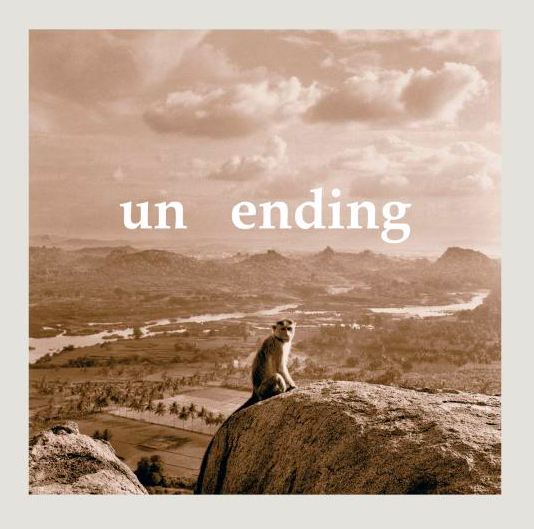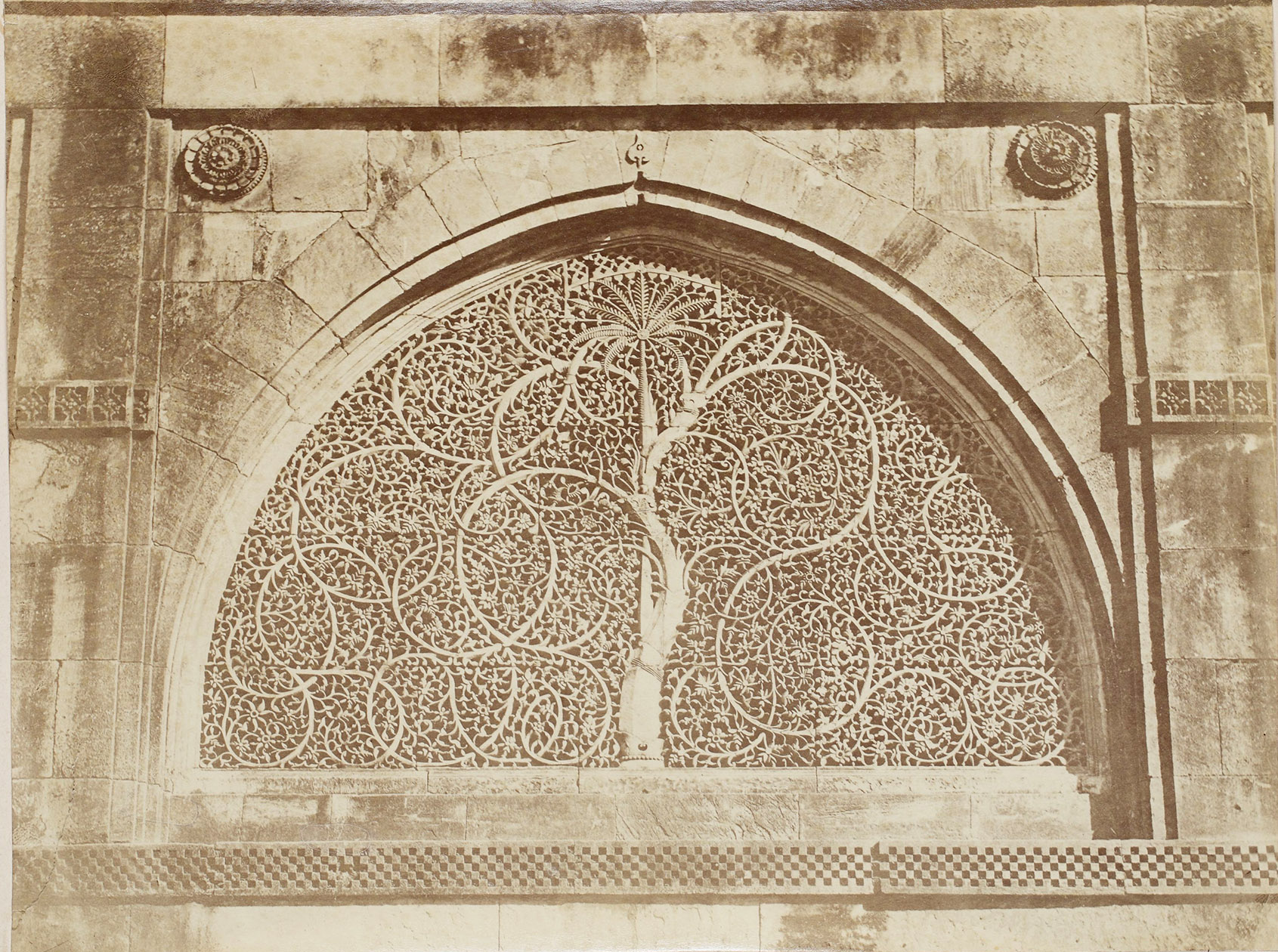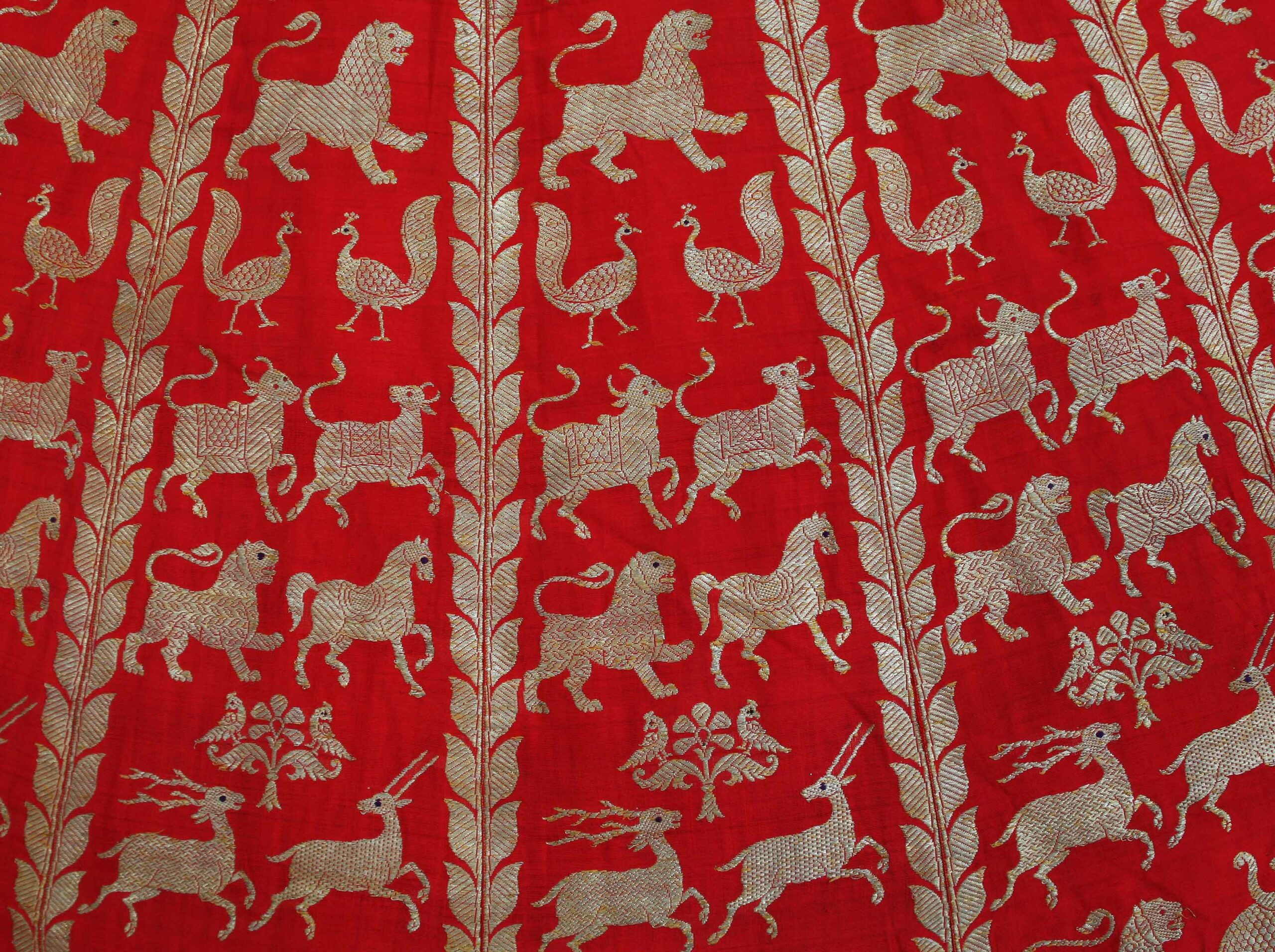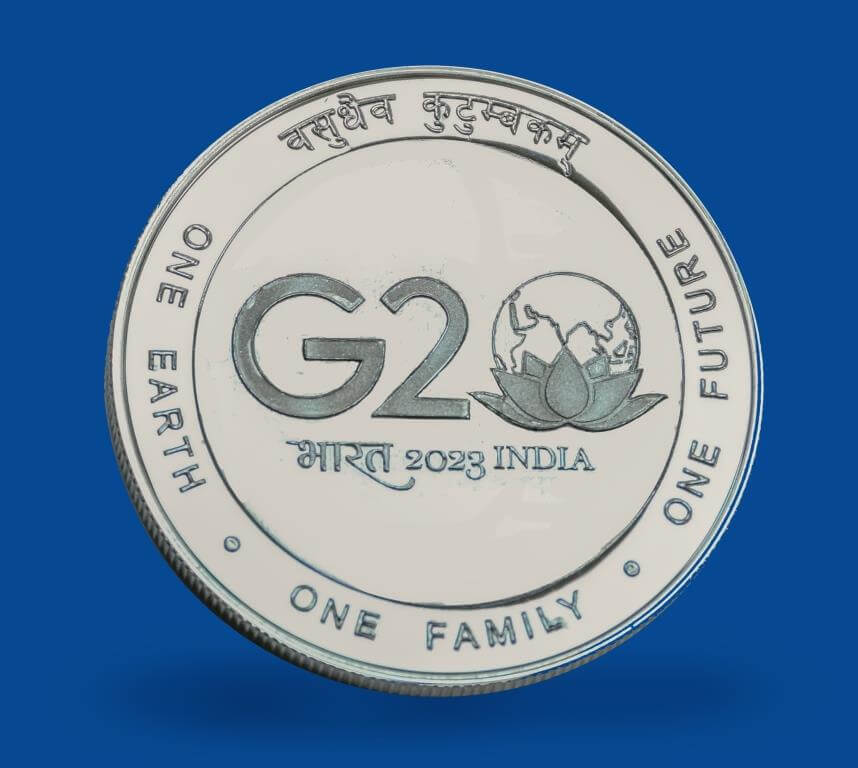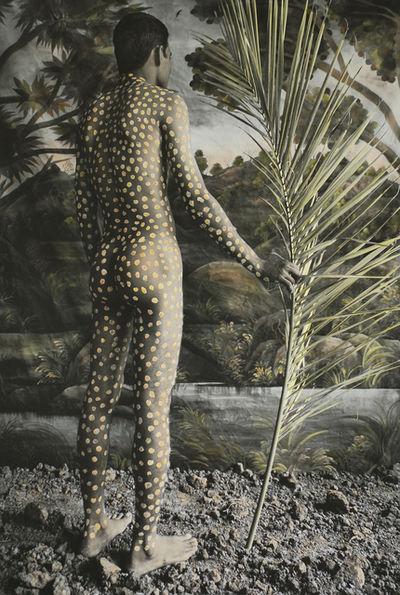
‘Night Prowl’, painted photograph by Waswo X. Waswo and Rajesh Soni © Sarmaya Arts Foundation
When I was asked to interview Waswo X. Waswo for this piece, the name sounded oddly familiar. A quick Google search revealed that he was the mysterious artist behind Night Prowl, a handcoloured photographic work featuring a young boy covered in tiger stripes, wearing a tribal mask. That image left an impression on me years ago when I first saw it and I made a quick mental note to learn more about the artist. It had slipped my mind until now when the opportunity presented itself. On a cloudy Wednesday morning, 66-year-old Waswo X. Waswo gets on a video call with me from his home in Varda, located on the outskirts of Udaipur, Rajasthan, where he also operates his studio.
It doesn’t take me long to learn that the multidisciplinary artist, collector and writer was born in Milwaukee, Wisconsin. He studied photography at the University of Wisconsin, and later at Studio Marangoni, Centre for Contemporary Photography in Florence, Italy. In the early Noughties, after extensive travels in India and South-East Asia, Waswo made Udaipur his home, where he began collaborating with local artists to produce a large body of diverse work. With several solo and group exhibitions and five books to his name Waswo X. Waswo soon became well established in the Indian art circles.
Today, Waswo’s artistic oeuvre is dominated by two streams that often intertwine and inform each other. A common thread that runs through both streams is the easy, relaxed manner in which they bring the quotidian to life. On the one hand, are his hand-coloured photographic portraits co-created with third-generation photo-colourist Rajesh Soni, and on the other, are a series of contemporary miniatures, conceptualised by him and realised with the help of Udaipur-based miniaturist R Vijay. Waswo says, “One my collectors in Amsterdam said that when you first look at my pictures you know what you’re seeing. Then you realise what you first saw is not correct and you’re forced to look at them again, which leaves you with this strange feeling that you’re caught in the middle.”
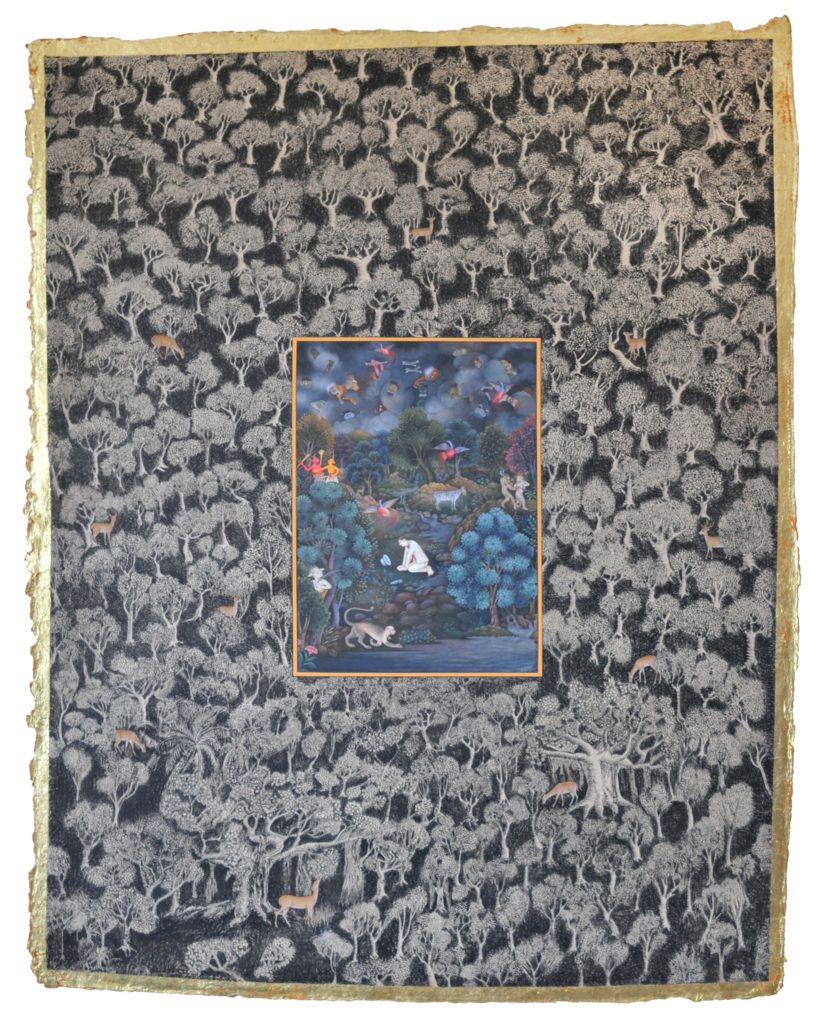
Untitled from the series ‘Pages from a Burning Storybook’, gouache and gold with thread on wasli paper by Waswo X. Waswo with R Vijay © Sarmaya Arts Foundation
While his practice crosses over genres and cultural references, Waswo’s work is sometimes critiqued for its colonial gaze. The artist is quick to dismiss this. He states that his art is a reflection of how he experiences the world; he doesn’t hesitate to turn the gaze on himself. “I want people to look at my images with a poetic sensibility. Whether they’re miniatures or photographs — I don’t want them to be picked apart for cultural or political meanings.” Through our conversation I learn that Waswo’s art and creativity are byproducts of his fascinating lifestyle, of living and creating in a community — an artistic end achieved through conversation and shared experiences.
Waswo now divides his time between his studio in Udaipur and his partner of 30 years, Tommy, who now lives in Bangkok and features prominently in his miniatures. Meeting his collaborators has impacted his trajectory as an artist. “Each piece is a negotiation. I’ve had to unlearn a lot, I’ve loosened up and a large part of that comes from collaborating with other people,” he says. In this excerpted interview and in his own easy-going yet meticulous manner, Waswo talks me through the process of finding himself by creating a life completely disconnected from the one he was born into, his unique brand of collaborative art and his undying love for chai.
When did you start making art?
I loved painting as a child. My mom was an oil painter and she always encouraged me. I’ve always maintained a studio where I have been practising some form of art. At college, however, my major was in creative writing. I really wanted to be a writer. My new book that’s coming out soon, titled The Gauri Dancers, includes a short story. After college I was very lost. I was a hippie stoner—at that point in 1970s America, everyone was. That’s when I met Edward Farber, who was a photographer with the Milwaukee newspaper. He literally put a camera in my hand and directed me to the Milwaukee Centre For Photography and said, ‘The camera is your passport and it will open doors.’ He inspired me to go back to school and that gave me focus and pushed me forward in my artistic journey.
So who is Waswo X. Waswo? You’re known for never answering that question.
I stopped talking about my name early on because journalists used to be so fascinated with it, that they would make the whole story about my name, talking very little about my art. I was born Richard John Waswo. When I started exhibiting my abstract paintings in the US, I did it under my last name. As I started to slowly form a connection with India (my first time here was in 1993 but by 1999-2000 I was pretty much living here at least half the year), I decided to change my name. Around this time I had gone to see an exhibition at the National Portrait Gallery in London. It was by the American-German photographer Horst P. Horst who was born Horst Bohrmann. Then came the wars between the US and Germany and he didn’t want the German association any more. So he dropped his last name and doubled his first name. I remember walking out of the exhibition saying, ‘If he can be Horst P Horst I can be Waswo X Waswo’ (laughs). The joke stuck and here we are. There was also a famous historian called Richard Waswo. As Google came in very powerfully in the late 90s, early 2000s, if you Googled my name, all of his work popped up. So, from a practical standpoint, I separated myself with Waswo X. Waswo.
How did you come to collaborate with others on your art?
In 2004 when I travelled through India as a tourist, shooting with my Roloflex and making sepia photographs, I realised something was missing. There were emotions I couldn’t express through my photography alone because it was directed outwards and I wanted something that looked inward. I connected with a local shop owner named Arvind Sharma who used to commission a bunch of local artists to work for him. I had written some poetry that I screen-printed on to natural paper. I asked Arvind if he could do illuminated borders around them and possibly include little pictures that would relate to the poems. I travelled on and when I returned in about two months he had them all finished — they were absolutely beautiful! That was the first time I had worked with miniaturists.
At what point did you decide to feature in your art as a character?
My next work was The Secret Life of Waswo X. Waswo— a series through which I expressed a narrative of things that had occurred to me as I travelled through India. It included a sex miniature, which was slightly controversial, but it was part of my life travelling as a gay man in India. Around this time is when I met Rakesh (R Vijay), with whom I co-create my miniatures even today. Initially the work was autobiographical, but as I continued working on the miniatures, things evolved. I had started to feel that I was fitting in very much with my new life. I stopped wearing those stupid white fedora hats (laughs) and round glasses. All this while, [that persona] remained in the past — the permanent tourist, the outsider, a bumbling fool travelling through India. He no longer represented me. But every once in a while, when we make a miniature I still inhabit him because [he represents] a direct relation to some emotion I am feeling. By and large, though, he is his own person now.
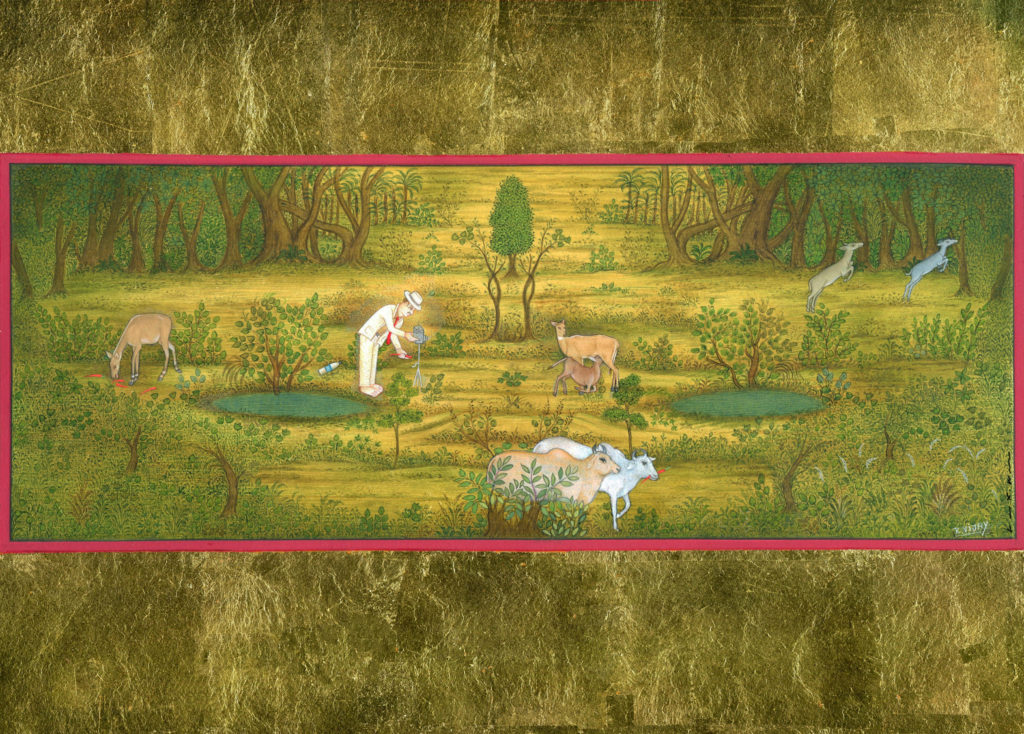
Miniature from the series ‘Pages from a burning storybook’, gold and pigment on wasli, by Waswo X Waswo with R Vijay © Sarmaya Arts Foundation
What’s the collaborative process like on the miniatures?
Sometimes people get rather flippant with me and say ‘Oh! So you just come up with some ideas and R Vijay does all the work?’ Yes I do come up with the ideas and make initial sketches and a plan. Then we talk and he makes the drawing and then many times what he has made has problems. I then tell him this has to be changed, that has to be made bigger or smaller. Sometimes he comes back on my ideas and advises me culturally. And even when he’s in the painting process I’ll go to his studio and give him feedback. There’s a lot of interaction back and forth. He needs my involvement just as much as I need him. That’s why I call it a collaboration. We’ve done it for nearly 12 years and it’s going really well.
How did the idea of creating layered photographs come about?
When I travelled around in India making sepia phtographs, it was important for me to have exhibitions in India, because back then very few foreigners did that—most of them just came to India, shot a lot of pictures, went back to the US, Europe, Australia or Japan and showed their work there. So I started working with Alliance Française who gave me some shows. Those were early days and I got some good feedback. In 2002-2003, India and China were poised to be the two new economic powerhouses of the world. People felt my photographs went against that narrative. They felt I was trying to hold India back in the past but to me they were just beautiful photographs. I realised there was a problem and people were confusing my pictorial approach with a documentary approach.
I thought, well, if we go back to the old way of doing things, with a painted backdrop in a studio, it will announce the fact that it is a set-up, a fake. So that was a sort of initial impetus. At the beginning, the portraits were pure black and white and there was no intention of having them coloured. Then when I started to work with Rakesh (R Vijay) on my miniatures, Rajesh Soni acted as my liaison and translator. One day he came over and saw me making these black and white prints and he said, ‘O chacha, we can paint these.’ That’s when I learnt his whole history: his late grandfather was the famous artist and photographer Prabhu Lal Vermawho worked for the late Maharajah Bophal Singh of Mewar. Not only did he take photos at the court, he printed and handcoloured them too. This skill was passed down from Prabhu Lal Verma to Rajesh’s father and through him down to Rajesh. When he started to colour the photos, the outcome was a bit garish. We worked together to get it to be really subtle and translucent so that it still looked like a photograph with a bit of tint. And that’s how it all took off.
In the studio, I started to initially do portraits of people against formal backdrops and painted curtains. We occasionally threw in a plant, a chair or an oriental carpet. After that we just started to play and gradually our backdrops became more and more elaborate. And of course, the people that came and modelled had so much to give with their expressions and costumes. In a way, the photographs were an extension of the miniatures. To me, the miniatures are part of the photographer’s journey. As he travels through the miniature landscape, the same visual is transported to the backdrop of the photo.
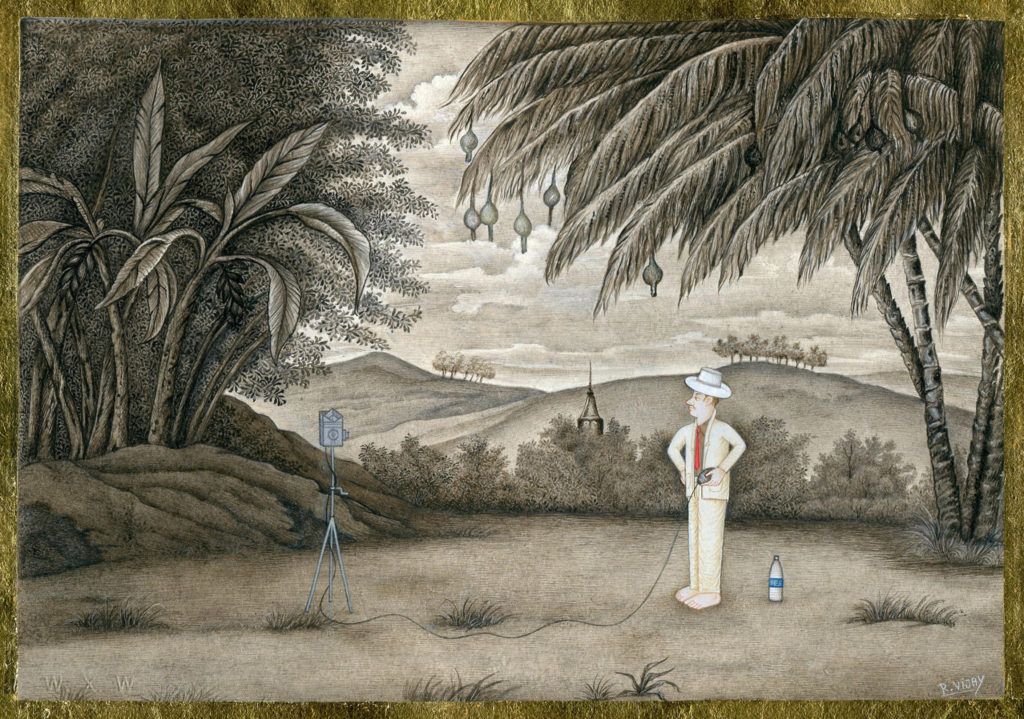
Miniature by R Vijay and Waswo X Waswo © Sarmaya Arts Foundation
Because these are collaborative pieces, how do you determine the ownership of the artworks?
With the handcoloured photographs it’s pretty simple — I sign on the front of the photograph and Rajesh Soni signs on the back. With the miniatures, initially R Vijay used to sign on the front and I used to sign on the back, because I could never paint like that. However, when we signed up with Gallery Espace in Delhi, Renu Modi (the founder), insisted that I sign on the front as well because the collectors would want that. So then we worked out a way where I could make a small signature and somehow hide it in the body of the image. R Vijay’s signature is also quite small as it is not customary to sign your work in the miniature tradition.
You’re also a collector of Indian printmaking.
I’ve always collected art —I bought pieces here and there and it was all quite scattered. Then in 2003, I decided that my collection needed some focus. That’s the time the Indian art market had started to boom and I wanted to buy art but it was all getting so pricey. Interestingly, what I found nobody was taking interest in were prints. When I looked back at what I had already bought, I realised I liked works on paper. I had a wonderful etching by Henry Moore and a couple of them by Wifredo Lam. I also had works by South American artists Roberto Matta and Rufino Tamayo. The first Indian print I bought was a beautiful etching by Bhupen Khakhar. Then I started going to Delhi art galleries and in those days, you could buy a beautiful little Haren Das for a really good price. Very quickly, over the course of 10 years, I built this huge collection of over 250 prints, including works by Bengali masters like Nandalal Bose and Mukul Dey, and Delhi artists like Devyani Krishna and Kanchan Chander. Then I wanted to show it off. So I had an exhibition at the India Habitat Centre, followed by exhibitions at NGMA Bangalore and Mumbai. When the collection came back to Udaipur I had to rent a godown to store it. I thought, ‘I am getting old, let’s make the donation.’ So I donated the collection to the University of Iowa Stanley Museum of Art.
What does the idea of home mean to you?
Home feels like Udaipur now and I see it reflected in my own language. For instance, I’ll say, ‘I have to go to Bangkok and see Tommy.’ Tommy is my partner and we’ve been together for about 30 years. We’re not joined at the hip but we still talk to each other everyday. And when I go to the US to renew my visa, I find myself saying, ‘I have to go back to the US’ and I am not so eager to go. I love the big cities— I love Chicago, New York, San Francisco… When I left the US, though, I was very happy to leave because I was disgusted with where it was going politically (under George Bush at the time). But as I’ve been here longer and longer I’ve realised you can never really break your roots. I’ve so much Americanism in me now. I find myself really getting emotional over American politics. I am still very western. Western civilization has contributed a lot of positive things to the world and I feel sad that it gets thrashed as much as it does today.
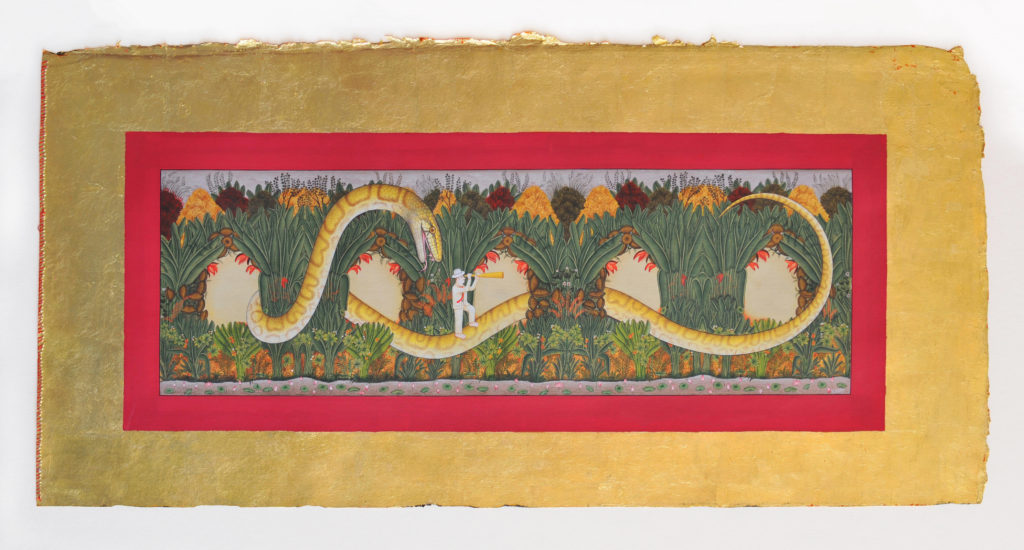
Miniature by Waswo X. Waswo with R Vijay © Sarmaya Arts Foundation
You have completely integrated into the Indian life. What are the most joyful aspects about that besides the chai?
In Udaipur, there’s an incredible amount of freedom. When you talk about freedom Americans understand it in political terms. Are you free to vote? Do you have freedom of speech? Are you free to peacefully assemble at protests? And those are all very important. When I am in India, I find freedom is often just the freedom to ride on a motorcycle without a helmet, without being stopped. Sometimes Udaipur feels a little bit like a frontier. When I was a child, I wished that I had been born in the Wild Wild West because it always seemed like such an adventure and now I realise that I’ve lived in the Wild Wild West, in a way, but it’s been in Udaipur (laughs). I like the sense of casualness that Indians have, the super-friendliness, the lack of pretense, at least among the common people. Of course, that changes when you get to Delhi and you’re at an art opening. But here, where I live, it’s all very casual. And it does come back to chai, in ways, you know. We sit around…have a chai, sit on the floor and talk, pass around a cigarette… I like the intimacy and camaraderie and the sense of freedom in that.
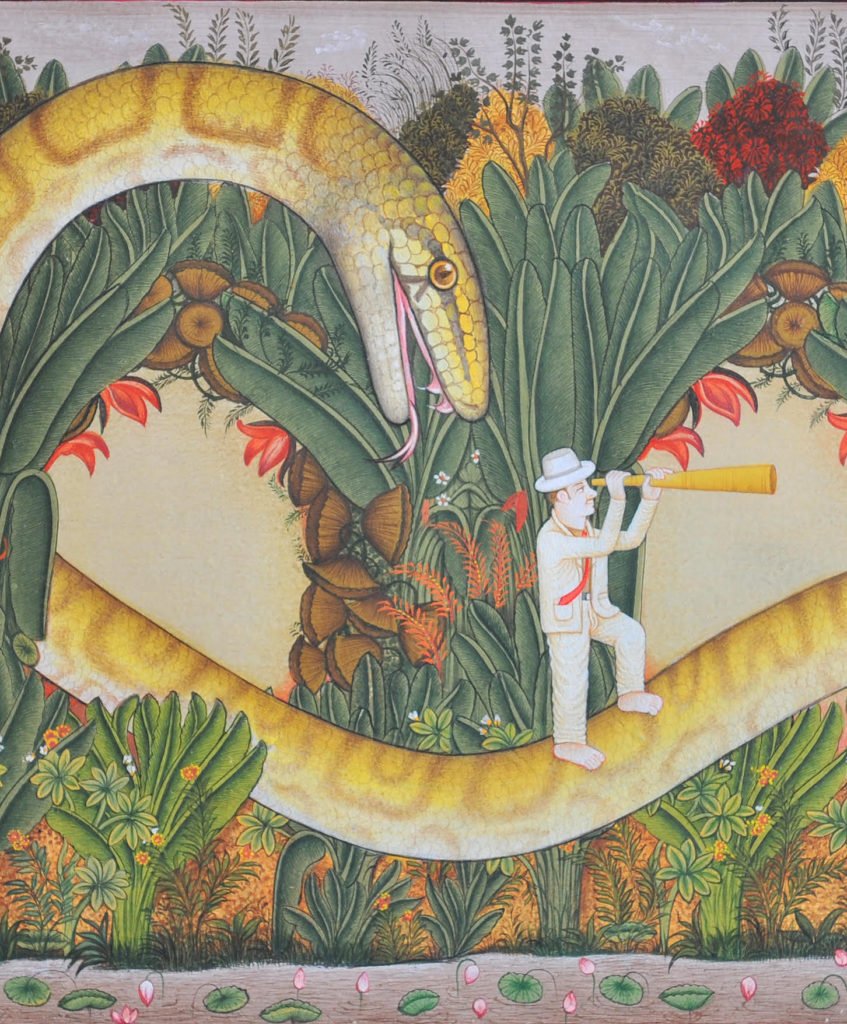
Is there ever a feeling of restlessness? How does that reflect in your art?
Yes (laughs). The miniatures have mutated over time. Shankar Kumawat, who does our borders, has now invaded the canvas, putting more of his work on the actual miniature. I don’t want to make a radical change. To me, the art has to evolve slowly and methodically. That said, I don’t want it to seem like we’ve become a brand where all the pieces look the same, and when you’ve seen one you’ve seen them all, which happens with a lot of contemporary sculptors and artists. I like to keep a sense of surprise in my miniatures. And you’ll see that in the show that opens in October at (Gallery) Espace (in Delhi).

